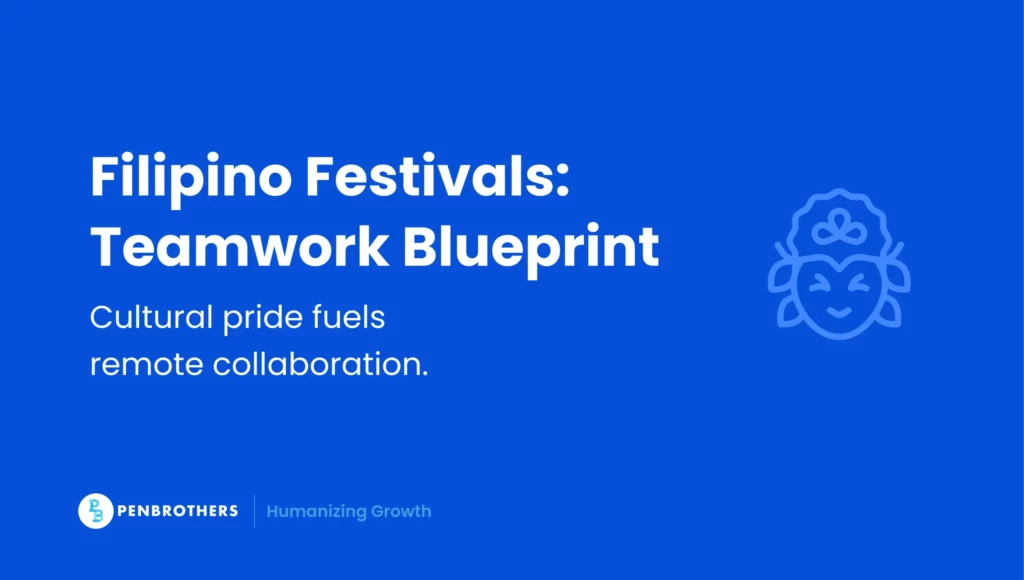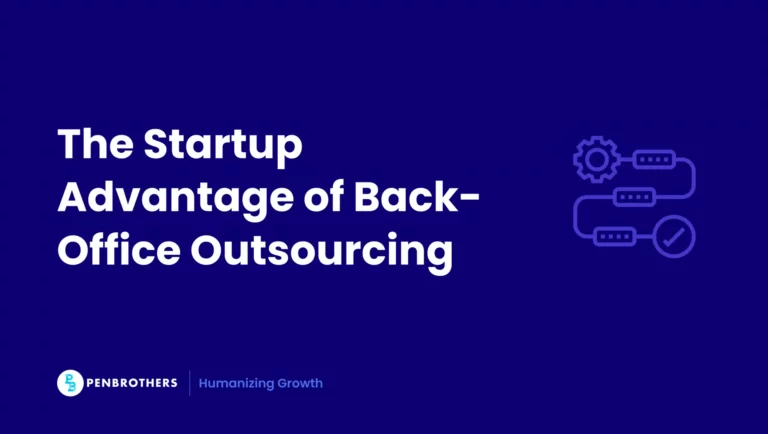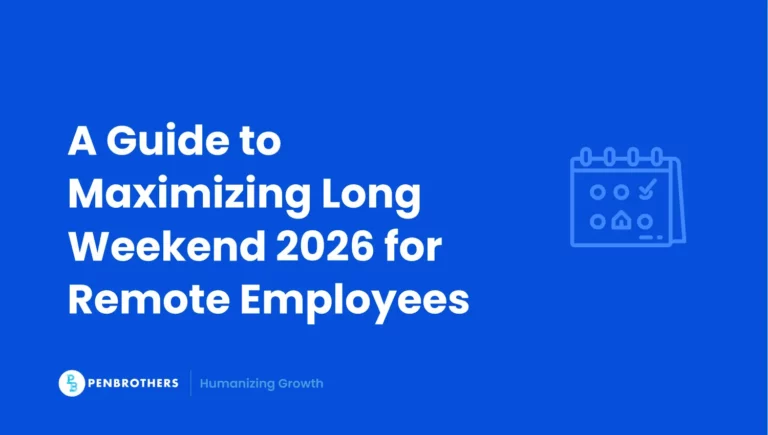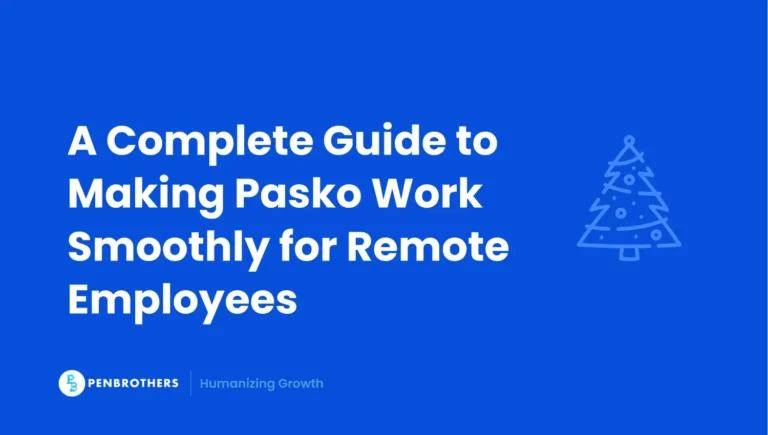Key Takeaways
- Festivals aren’t just cultural. They’re a living blueprint for teamwork. Every successful celebration mirrors how Filipinos thrive in remote teams: collective effort, clear roles, and shared joy.
- The “biggest” festival isn’t only about scale. It’s about inclusivity. Just like in Sinulog or Ati-Atihan, remote teams succeed when everyone, from the center to the sidelines, feels part of the rhythm.
- With over 40,000 festivals, the Philippines shows one thing clearly: there’s always a reason to connect. Remote collaboration can borrow this same principle: create rituals that bind teams together across borders.
Introduction: Why Festivals Matter Beyond Celebration
If you’ve ever been in the Philippines during a festival, you’ll notice something right away: everything stops, and everyone comes together. Streets are closed, colors take over, music fills the air, and suddenly, work and worries pause. It’s not just about parades or costumes—it’s about community in motion.
For Filipinos, festivals are more than entertainment. They are a living classroom of values: resilience, unity, and creativity. And here’s where it gets interesting: those same values quietly fuel how Filipino professionals thrive in remote teams.
So if you’ve ever wondered why Filipino talent is known for collaboration, adaptability, and positivity, the answer may be found in the same streets that come alive with drums and dancing.
What are the Top 10 Festivals in the Philippines?
From Luzon to Mindanao, every region has a festival worth celebrating. Here are ten of the most iconic ones, but instead of just looking at them as tourist events, let’s uncover what they teach us about Filipino work culture:
- Sinulog (Cebu): A festival of devotion and unity. Work parallel: building cohesion in diverse teams.
- Ati-Atihan (Aklan): A celebration of cultural identity. Work parallel: embracing inclusivity in remote setups.
- MassKara (Bacolod): Known as the “Festival of Smiles.” Work parallel: resilience during challenging projects.
- Panagbenga (Baguio): A flower festival symbolizing renewal. Work parallel: creativity in problem-solving.
- Kadayawan (Davao): A thanksgiving for nature’s bounty. Work parallel: gratitude as a motivator for performance.
- Dinagyang (Iloilo): Vibrant dances and synchronized movement. Work parallel: structured yet innovative teamwork.
- Pahiyas (Quezon): Showcases artistry in decorating homes with harvest produce. Work parallel: craftsmanship in deliverables.
- Higantes (Rizal): Giant papier-mâché figures parade the streets. Work parallel: storytelling and visual communication.
- Moriones (Marinduque): Colorful re-enactments of devotion. Work parallel: discipline and accountability in roles.
- Pintados (Leyte): Tattooed dancers display warrior heritage. Work parallel: authenticity and pride in one’s craft.
What is the Biggest Festival in the Philippines?
The Sinulog Festival in Cebu is widely regarded as the biggest, drawing millions of locals and international visitors each year. But beyond its size, what makes Sinulog remarkable is the complexity of its organization. Thousands of performers, dozens of contingents, multiple days of events all requiring coordination across communities, institutions, and sponsors.
Large-Scale Collaboration Lessons from Sinulog
Organizing Sinulog is like managing a global project:
- It requires distributed leadership: No single group can pull it off alone.
- It demands creativity and tradition to work hand in hand; just as modern remote teams balance innovation with client expectations.
- It thrives on synchronized execution, where every dancer, drummer, and designer knows their role.
This is the same DNA Filipino professionals bring into remote teams: an ability to execute at scale, coordinate across borders, and still deliver with heart.
How Many Filipino Festivals are There?
The Philippines has over 42,000 festivals nationwide. Nearly every city, town, and barangay has at least one celebration, whether rooted in religion, harvest, or history.
This staggering number tells us something profound: Filipinos are wired for resilience, adaptability, and joy. No matter the challenges such as typhoons, economic struggles, or global shifts. There’s always a reason to gather, celebrate, and move forward.
What 40,000+ Festivals Teach About Filipino Work Culture
When you work with Filipino remote teams, you notice these same traits:
- Joy as fuel: Even in high-pressure projects, Filipinos keep morale alive.
- Adaptability: Just as festivals adjust to weather or budget, professionals find ways to deliver despite constraints.
- Community-first mindset: Work isn’t just transactional. It’s relational.
For global employers, this means you’re working with teams who see challenges not as setbacks, but as opportunities to prove resilience and unity.
Beyond the Parade: Hidden Lessons Festivals Teach Filipino Professionals
Festivals also reveal subtler lessons that shape Filipino professionals:
- Leadership: Barangay leaders and volunteers step up to organize festivals, mirroring how Filipinos naturally take ownership of projects.
- Resourcefulness: Communities recycle, repurpose, and innovate to make festivals happen, just like teams do with limited tools or budgets.
- Collaboration: Everyone has a role, and no role is too small. This translates into respect for every team member in remote work.
- Resilience: Festivals continue even after calamities. This grit shows up in how Filipinos bounce back from setbacks.
These aren’t abstract values. They’re lived realities.
Festivals and Work-Life Balance in Remote Teams
Ask any Filipino: festivals aren’t optional. They’re moments to pause, reconnect, and celebrate. This sacred rhythm teaches the importance of balance between work and life.
In remote teams, this manifests as:
- Strong boundaries: Knowing when to focus deeply and when to rest.
- Rejuvenation: Festivals provide cultural “reset buttons,” preventing burnout.
- Trust and Loyalty: Employers who acknowledge and respect festival times often gain deeper trust and commitment.
Global employers who plan around these cultural touchpoints see higher engagement and retention. A simple act—like giving flexible hours during Sinulog or Panagbenga—can translate into long-term loyalty.
Practical Guide: How Global Teams Can Celebrate Festivals with Their Filipino Colleagues
If you’re working with a Filipino remote team, here are ways to bring festivals into the workplace meaningfully:
- Acknowledge: Add major festivals into the shared calendar.
- Engage: Host virtual activities like trivia, storytelling, or cultural showcases.
- Celebrate: Encourage themed dress codes or simple cultural exchanges during festivals.
- Recognize: Align appreciation or team milestones with cultural moments.
These gestures don’t just respect culture. They strengthen bonds across borders.
Conclusion: Festivals as the Blueprint of Filipino Professional Excellence
Filipino festivals are not just parades, dances, or costumes. They are living systems of resilience, collaboration, and leadership. And when these values spill into the workplace, they explain why Filipino remote professionals are among the most trusted worldwide.For global employers, recognizing and embracing this cultural heartbeat doesn’t just make business sense. It creates stronger, more loyal, and more human teams. If you’re looking to build a remote team with a work culture that delivers value and diversity, we can help you build that.






